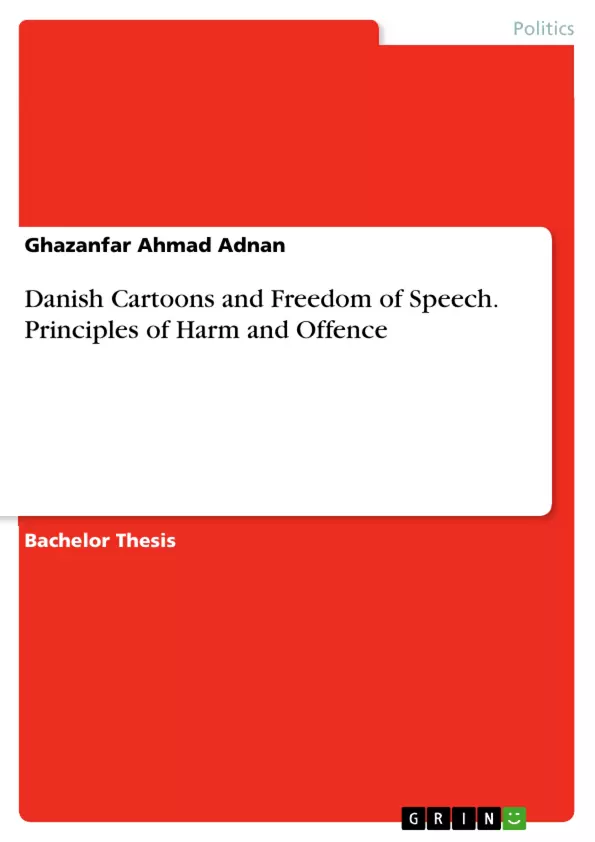The problem emerges as a result of cartoons of Prophet Mohammad (P.B.U.H.) in 2005 by the Danish Newspaper "Jayllands Posten". It created a situation that exposed the differences of different worlds based on religions and beliefs. Freedom of expression and opinion in international instruments based on acknowledged human rights became controversial in relation to rights and duties. In regards to Danish cartoons, principles of harm and offence as explained by Mill and Feinberg and their legal validity are applied to judge the situation. Laws are based on norms and values philosophically exerted out of customs and practices. I would present that human behaviors are meant to be treated based on realities but not on cynic philosophical argumentations or debates.
My purpose of research on the cartoons violence issue is to explain the moral grounds of universal human rights standards required to solve the dilemma peacefully. I have presented past, present and future of the controversy. All the conflict is misrepresented if they are presented out of context in relation to discussing the history of the conflict. For instance all the conflicts which are a threat to world peace have long history. And almost all the conflicts are based on religious grounds, for instance Palestine, Kashmir and the recent phenomenon terrorism is not out of this circle at all. My aim was to understand and give a brief but broad view of the cartoon controversy by describing its past as well. Describing religious conflict as the historical background does not mean we are still following the past but my aim was to show the current situation of our world which has become a global village in which personal bias of a single person can escalate a world conflict if few people decide to manipulate the situation. I certainly disprove any "clash of civilizations" but wanted to explain how we can build bridges among different cultural and social differences.
Inhaltsverzeichnis (Table of Contents)
- Chapter 1
- 1.1 Introduction
- 1.2 Aim of research
- 1.3 Research questions
- 1.4 Theory
- 1.5 Method and material
- 1.6 Disposition
- Chapter 2
- 2.1 Historical Background into Religious hatred and Cartoons Controversy
- Chapter 3
- 3.1 Freedom of speech; an absolute right or not?
- 3.2 The Clash of rights: Freedom of Speech and Freedom of Religion
- 3.3 Derogation in case of Maintenance of International Peace and Security
- 3.4 Freedom of Speech and Religious Discrimination
- 3.5 Freedom of Speech and Propaganda for Religious Hatred
- 3.6 The Right and Reputation of Others and Freedom of Speech
- 3.7 Freedom of Speech and Universal Morals
- 3.8 Universal Human Rights and Cartoons
- Chapter 4
- 4.1 Freedom of speech under human values and norms
- 4.2 Mill's harm principle
- 4.3 Feinburg's offence principle
- 4.4 Democratic values
Zielsetzung und Themenschwerpunkte (Objectives and Key Themes)
This research explores the moral and legal implications of the Danish cartoons controversy, aiming to understand the conflict between freedom of speech and religious sensibilities. It examines the historical context, the clash of rights, and the application of principles like harm and offence to address this complex issue.
- Freedom of Speech and its limits
- Clash between Freedom of Speech and Freedom of Religion
- Religious Sensitivity and Cultural Differences
- Harm and Offence principles in relation to human rights
- Universal human rights in a globalized world
Zusammenfassung der Kapitel (Chapter Summaries)
- Chapter 1: This chapter provides an introduction to the research topic, outlining the aim and research questions. It discusses the concept of freedom of speech in the context of globalization and the need for peaceful resolution of differences in a diverse world. The chapter highlights the dynamic nature of human rights and how their interpretation evolves with social and cultural progress. The chapter also delves into the historical context of the Danish cartoons controversy, tracing the events leading to the publication of cartoons and the subsequent reactions.
- Chapter 2: This chapter delves into the historical background of religious hatred and cartoon controversies, setting the stage for understanding the complex dynamics at play in the Danish cartoon case. It provides a historical context for the issues raised in the research.
- Chapter 3: This chapter examines the concept of freedom of speech, exploring whether it is an absolute right or subject to limitations. It then investigates the clash between freedom of speech and freedom of religion, focusing on the potential for derogation in the context of maintaining international peace and security. The chapter also explores the intersection of freedom of speech with religious discrimination, propaganda for religious hatred, the right and reputation of others, and universal morals. It examines how these considerations interact with the principle of freedom of expression.
- Chapter 4: This chapter explores the concept of freedom of speech within the framework of human values and norms. It analyzes Mill's harm principle and Feinburg's offense principle, examining how these principles might be applied to the Danish cartoon case. The chapter further examines the role of democratic values in navigating the tensions between freedom of expression and other rights.
Schlüsselwörter (Keywords)
This research focuses on key topics such as freedom of speech, freedom of religion, religious sensitivity, cultural differences, harm and offence principles, universal human rights, and the Danish cartoons controversy. These keywords encapsulate the primary concerns and debates surrounding the intersection of individual rights and cultural values in a globalized world.
- Citar trabajo
- Ghazanfar Ahmad Adnan (Autor), 2013, Danish Cartoons and Freedom of Speech. Principles of Harm and Offence, Múnich, GRIN Verlag, https://www.grin.com/document/349951



